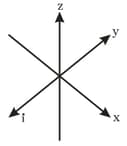Biot-Savart Law and Its Application
Biot-Savart Law and Its Application: Overview
This Topic covers sub-topics such as Biot-Savart Law, Permeability of Free Space, Magnetic Field on the Axis of a Circular Current Loop, Magnetic Field of a Moving Charge, Current Element and, Comparison between Biot-Savart Law and Coulomb's Law
Important Questions on Biot-Savart Law and Its Application
Two very long straight parallel wires, parallel to -axis, carry currents and , along -direction and -direction, respectively. The wires pass through the -axis at the points and respectively. The graph of magnetic field -component as one moves along the -axis from to , is best given by
Equal current i is flowing in three infinitely long wires along positive x, y and z directions. The magnitude field at a point (0, 0, -a) would be:
Find the magnetic field at due to the arrangement shown.
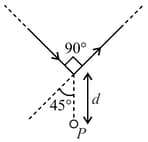
Two mutually perpendicular conductors carrying currents respectively, lie in one plane. Locus of the point at which the magnetic induction is zero, is a:
A current I flows around a closed path in the horizontal plane of the circle as shown in the figure. The path consists of eight arcs with alternating radii r and 2r. Each segment of arc subtends equal angle at the common centre P. The magnetic field produced by current path at point P is
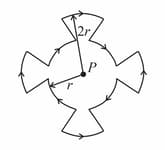
Two concentric coils and of radii and lie in the same vertical plane containing direction. has turns and carries . has turns & carries . has current in anticlockwise direction. The magnitude of net magnetic field at their common centre is-

Three rings, each having equal radius R, are placed mutually perpendicular to each other and each having its centre at the origin of co-ordinate system. If current I is flowing through each ring then the magnitude of the magnetic field at the common centre is
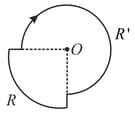
A current of ampere is flowing through each of the bent wires as shown the magnitude and direction of magnetic field is,
An infinitely long conductor is bent to form a right angle as shown. A current flows through . The magnetic field due to this current at the point is . Now, another infinitely long straight conductor is connected at so that the current in remaining unchanged. The magnetic field at is now . The ratio is,
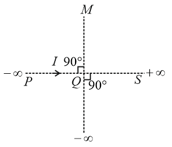
Three infinitely long thin wires each carrying current in the same direction, are in the x-y plane a gravity-free space. The central wire is along the y-axis while the other two are along Find the locus of the points for which the magnetic field B is zero.
A ring of the radius is placed in the plane and it carries a current . The conducting wires which are used to supply the current to the ring can be assumed to be very long and are placed as shown in the figure. The magnitude of the magnetic field at the centre of the ring is

Find the magnetic induction at point O, if the current carrying wire is in the shape shown in the figure.
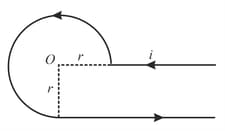
Find the magnetic induction at point , if the current carrying wire is in the shape shown in the figure.

Find the magnetic induction at the origin in the figure shown.
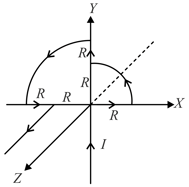
Find the magnetic induction at the origin in the figure shown.
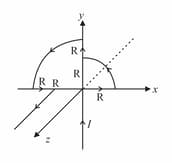
Find the magnetic field at the centre P of square of side a shown in figure.
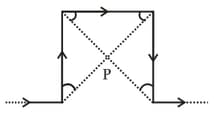
Two circular coils A and B of radius cm and 5 cm respectively current 5 Amp. and Amp. respectively. The plane of B is perpendicular to plane of A their centres coincide. Find the magnetic field at the centre.
Figure shows a straight wire of length/carrying a current i. Find the magnitude of magnetic field produced by the current at point P.
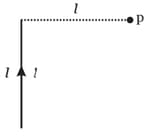
A system of long four parallel conductors whose sections with the plane of the drawing lie at the vertices of a square there flow four equal currents. The directions of these currents are as follows : those marked point away from the reader, while those marked with a dot point towards the reader. How is the vector of magnetic induction directed at the centre of the square ?
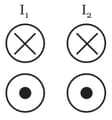
A long straight wire carries a current of directed along the negative axis as shown in the figure. A uniform magnetic field of magnitude is directed parallel to the axis. What is the resultant magnetic field at the following point ?
